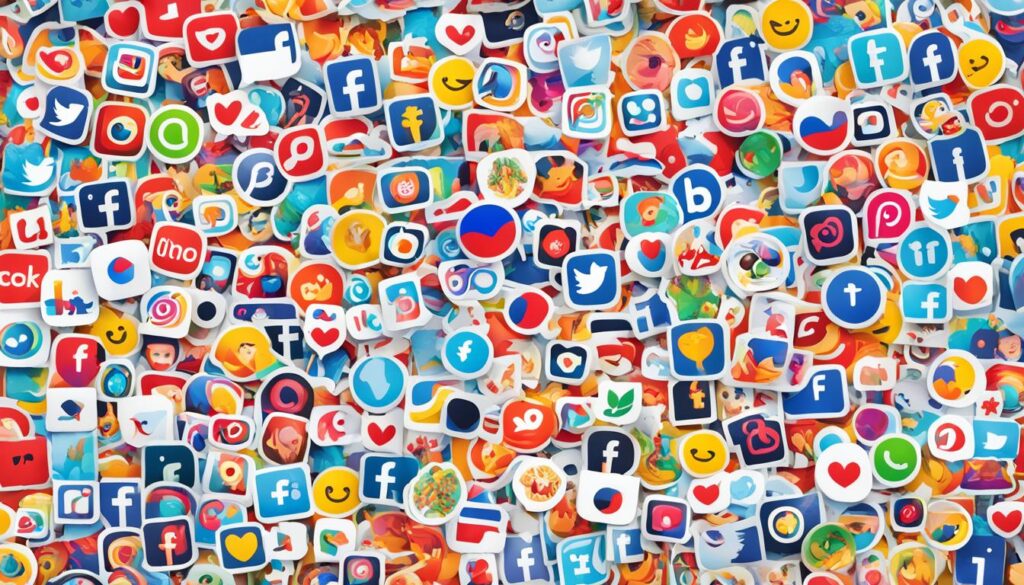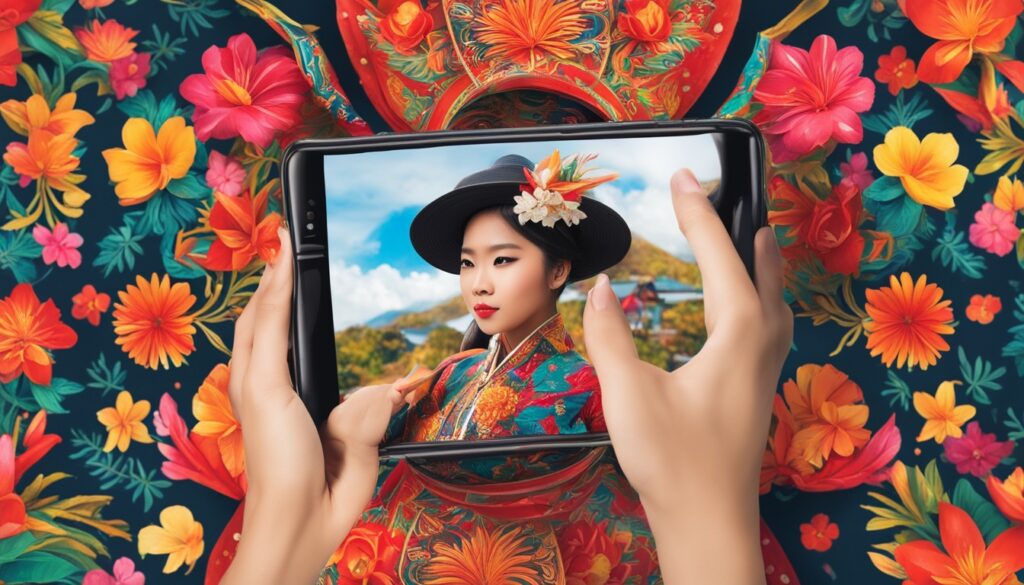Are you finding it hard to stand out on social media in the Philippines? Do you want to learn how to really connect with your audience and meet your marketing targets?
Social media marketing is now key for businesses wanting to engage their audience and build a solid brand image. This is even more important in the Philippines, where social media is deeply part of people’s lives. So, it’s vital to grasp the unique aspects of this market.
This piece will look at the best practices for doing well in social media marketing in the Philippines. We’ll dive into things like understanding the social media scene, finding your audience, crafting great content, and using analytics. You’ll learn everything you need to thrive in this tech-savvy country.

Key Takeaways:
- Understand the social media landscape in the Philippines and its influence on consumer behavior.
- Identify and understand your target audience’s demographics and preferences.
- Tailor your content for different social media platforms to maximize engagement.
- Integrate Filipino culture into your content to resonate with the local audience.
- Embrace mobile marketing opportunities given the high mobile usage in the Philippines.
Social Media Landscape Overview in the Philippines
The Philippines’ social media scene is bustling and molds Filipino culture. Many Filipinos actively use these platforms each day. They are central to how people live, communicate, and share.
Prevalence of Social Media in Filipino Culture
Social media is deeply woven into Filipino life, changing how people interact and share. It lets everyone express themselves and build communities online.
Thanks to smartphones and easy internet access, social media is a main way for Filipinos to stay in touch with loved ones. They also share their life moments and find interesting stuff online.
It touches many parts of life, from entertainment and news to how people shop and support causes they care about. For individuals and businesses, it’s a key way to reach a bigger audience. They can tell their stories, get their voices heard, and interact with others widely.
Statistics on Social Media Usage in the Philippines
As of 2020, there were about 73 million social media users in the Philippines, which is about 67.5% of the population. This shows the huge impact of these platforms in the country.
Most users have accounts on many platforms. Facebook is very popular, with over 71 million users in 2021. Other important sites include YouTube, Instagram, Twitter, and TikTok.
This data highlights a big chance for businesses to reach out to Filipino customers via social media. By knowing what people like and how they act online, companies can better engage their audience.
Top Platforms Influencing Filipino Consumers
Facebook is a big influencer, offering various ways to connect with people in the Philippines. YouTube is also popular, used for fun, learning, and checking out products.
Instagram shines for its eye-catching posts. It’s where people share their stylish clothes, travel adventures, and more. This makes it great for businesses to show off their products too.
Twitter stands out for news and quick info sharing. It’s a way for businesses to join in on discussions and reach people instantly.
For its part, TikTok has quickly become a favorite among young Filipinos. Its fun, creative videos are a hit, giving brands a chance to be creative and reach younger users.
Knowing which platforms influence consumers is key for businesses. Using these insights, they can connect better with their target market. This way, they can have a bigger impact in the Filipino market.
Identifying and Understanding the Filipino Audience
Marketing on social media in the Philippines needs understanding your target audience. We’ll dive into who uses social media in the Philippines. This includes their ages, genders, and where they live. Knowing this helps businesses create better marketing plans.
Demographic Breakdown of Users
In the Philippines, social media is big across ages and places. 63% of users are 18 to 34 years old, which is key for businesses. Half are male, half are female, showing a pretty even mix.
Metro Manila has the most social media users. But other big cities and provinces aren’t far behind. For your business to reach Filipinos online, knowing who they are is essential.

Consumer Behavior on Social Media
Filipinos are big on using social media to connect with loved ones and discover trends. They enjoy content that’s interesting, helpful, or catches their eye. They love sharing their thoughts on brands they like.
Posts that make Filipinos feel something or learn something new get their attention. This might be a funny post, a useful tip, or a piece that makes them think.
Businesses can grab attention by telling stories, sharing pictures from customers, or running contests. Talking to customers directly through comments can also do the trick.
Peak Activity Times for Engagement
Knowing when Filipinos are most active on social media is important for reaching them. The right time to post can make a big difference in how many people see and interact with your content.
Weekdays see the most social media action during lunch and in the early evening. These are the times when people are likely relaxing and checking their feeds.
Posting at the right time depends on the social media platform. And what works best for your business might not be the same for someone else. It’s a good idea to look at your analytics to see when your audience is most likely to engage.
By understanding who uses social media in the Philippines, how they act online, and when they are most active, businesses can make smarter marketing choices. This can help them reach their audience better and meet their marketing goals.
Strategizing Content for Different Social Media Platforms
Social media sites all have their special features and the kinds of people who like them. This means businesses need to think about what they post on each one. Doing this well helps businesses really connect with their audience on social media. Here are some ways to make your content work great on different platforms:
- Understand the platform: Knowing each site’s strengths and who uses it can make a big difference. When you understand who uses each platform and what they like, you can create content that really speaks to them.
- Create engaging posts: Making posts that catch the eye is key. Try using interesting titles, cool pictures, and clear messages. This makes people more likely to stop and pay attention to what you’re sharing.
- Utilize visuals: People love looking at photos, videos, and charts on social media. So, post things that look great and relate to what your business is about. It makes your content more fun to look at and share.
- Utilize storytelling techniques: Telling a good story can help you connect with your followers in a deep way. Share stories that show what your brand is all about. This will make your audience care more about what you have to say.
- Leverage platform-specific features: Use special tools on each site to your advantage. For example, on Instagram, use hashtags and the Stories feature. This can help more people find you. On Twitter, talk about what’s trending or join in on chats to get people talking with you.
When you plan and adjust your content for each social media site, you can really make an impact. This helps you catch the eye of the people you want to talk to most. It’s a key part of doing social media marketing well.
Integrating Culture in Content Creation
Filipino culture means a lot to people in the Philippines. In social media marketing, adding cultural elements to content can really help. Understanding and valuing Filipino culture makes a business more personal to its audience, building stronger loyalty.
Here are some tips for adding Filipino culture into social media content:
- Infuse cultural references: Make your social media posts more culturally relevant. Talk about Filipino traditions, customs, and events to connect better with your audience.
- Honor holidays and celebrations: Appreciate Filipino holidays and events by creating content for them. Make campaigns or greetings that show the festive spirit.
- Highlight traditions: Share stories about Filipino traditions, like festivals or unique practices. This will help people understand and appreciate the culture more.
- Use the local language: Put in some Filipino phrases or greetings. This will make your content more relatable and strengthen your connection with local people.
By bringing Filipino culture into your social media content, your business can become more culturally sensitive and relevant. This helps your brand’s message spread further and have a bigger effect.

Maximizing Mobile Marketing Opportunities
Mobile devices are now a big deal in the Philippines. They give businesses a chance to reach lots of eager customers. The Filipino market is moving strongly toward mobile. So, businesses must update their ways to engage effectively.
The Philippine market is seeing more people use mobile phones to go online. Most Filipinos, more than 70%, own smartphones. They also use the internet more on their phones than on computers. This trend shows why businesses need to focus more on mobile to connect with their customers.
Effective ads on mobile require a different approach. Ads should look good on smaller screens and load fast. This way, they can catch people’s eyes and turn them into customers more easily.
SMS marketing is big in the Philippines. Since many people use text messaging, sending SMS can be a great way to share messages. It’s a direct and effective method to communicate with a large number of people.
Mobile apps are another great way for businesses to connect with their audience. They offer easy access to products and personalized services. Having a useful app can make customers more loyal and engaged with the brand.
Targeting ads based on location is also smart for local businesses. This strategy uses a customer’s location to show ads that are more relevant. It can increase the chances of turning viewers into actual customers.
Importance of Mobile in the Filipino Market
Mobile phones have changed how Filipinos interact with brands and decide to buy. To be successful in the Philippines, businesses need to focus on mobile. The mobile-first approach is key to winning with Filipino consumers.
Filipinos rely on smartphones for internet access, social media, and more. It’s a big part of their daily life, from staying connected with friends to online shopping. This makes mobile a vital channel for businesses to reach customers.
Understanding mobile’s role in the Filipino market is crucial for businesses. It allows them to tailor their marketing to what customers want. Investing in mobile marketing means being where their customers are most, and engaging with them in meaningful ways.
Mobile-First Advertising Strategies
To reach Filipinos effectively on mobile, businesses need the right advertising approach. It’s more than just shrinking down ads meant for other media. It’s about creating ads that are appealing on mobile and offer a great user experience.
Some proven mobile-first strategies include:
- Creating flashy and attractive ads for mobile banners and displays.
- Using video ads made for mobile, which are typically shorter and catch the eye quicker.
- Using interactive ads to get users involved and interested.
- Adapting landing pages and site content to work well on phones, improving user experience.
- Using mobile retargeting to reconnect with users who have shown interest.
Following these mobile-first advertising strategies helps businesses get noticed on mobile devices. This enhances their outreach and boosts their chances of making sales.
tag is properly placed and styled to be visually appealing and relevant to the topic of maximizing mobile marketing opportunities.
Amplifying Reach with Social Media Advertising
Social media advertising helps businesses reach more people and connect with specific groups. In the Philippines, many people use social media, making it a key place for ads. With paid ads, companies there can attract a bigger audience and boost sales.
Using social media ads in the Philippines has many upsides. First, it lets businesses get seen by more than just their usual fans. This can make their brand more well-known.
Social media advertising gives businesses a chance to shine brighter, reaching people beyond their regular circles.
Also, these ads let you target exactly who you want to reach. For example, you can aim for people of certain ages or with certain hobbies. This makes ads more effective and helps meet marketing goals.
On top of that, companies can pick from different ad types. They can choose images, videos, or slideshows to match where the ad is shown and what the audience likes. This means ads are more interesting and grab attention better.
To make the most of social media ads in the Philippines, companies need good targeting. This means they should use data to pick the right audience, and check and adjust their ads’ performance. Doing this well keeps ads relevant and effective.
When companies make ad content, it has to stand out and clearly say what they’re about. They should use catchy titles, pretty pictures, and a clear message to get people interested and drive sales.
So, in the Philippines, social media advertising is a great way for companies to get noticed, reach the right people, and do well. By investing in ads, companies there can get in touch with their target audience, be more visible, and meet their marketing aims.

Elevating Engagement with Influencer Collaborations
In today’s digital age, influencer marketing is a key strategy for businesses. It helps them grow their reach and trust on social media. By working with well-known people, companies can reach more fans and make stronger connections. In the Philippines, this kind of marketing has worked really well. Brands there often use famous social media stars to improve their online presence. It’s important for companies to know how to pick the right influencers and work well with them.
Selecting the Right Influencers for Your Brand
Choosing the best influencers is critical for your marketing success. It’s not just about the number of the influencer’s followers. Their content and how real they are with their followers also matter. Focus on choosing influencers based on:
- Relevance: Choose influencers who share content that fits with what your brand is about. Their work should speak to the same kind of people you’re targeting.
- Engagement: Check how often people like, comment, or share an influencer’s posts. A high engagement rate means more people are involved and interested.
- Audience Demographics: Match an influencer’s audience to your target audience. Make sure they are similar in age, location, gender, and what they like.
By picking the right influencers, they can help your message get through and connect with more people in a meaningful way.
Best Practices for Influencer Partnerships
Making good partnerships with influencers is crucial. If you’re clear and give them space to be creative, they can do great things. Here’s how to do it well:
- Clear Guidelines: Be clear about what you expect and share your brand’s values with the influencer.
- Creative Freedom: Let the influencers show their creativity. This way, they can be real with their followers and make content that stands out.
- Transparency: Ask influencers to tell people when they’re working with your brand. This keeps their followers’ trust and follows the rules.
- Measurement and Tracking: Set goals and ways to measure how well the partnership is doing. This helps you make your marketing even better.
Using these tips can help your brand and influencers work well together. This can lead to more engagement, better recognition, and more growth for your business.
| Influencer Collaboration Best Practices | Description |
|---|---|
| Relevance | Select influencers whose content aligns with your brand’s niche and target audience. |
| Engagement | Evaluate an influencer’s engagement rate to ensure an active and loyal audience. |
| Audience Demographics | Consider an influencer’s audience demographics to ensure they match your target market. |
| Clear Guidelines | Set clear expectations and guidelines for the collaboration. |
| Creative Freedom | Allow influencers to have creative freedom in content creation. |
| Transparency | Encourage influencers to disclose partnerships to maintain trust. |
| Measurement and Tracking | Establish KPIs and track the success of influencer partnerships. |
Leveraging Video Content in Digital Marketing
Video content grabs people’s attention on social media. In the Philippines, video marketing is key to reaching the local audience. To make the most of video in your digital marketing, follow these tips:
- Create engaging and informative videos: Make sure your videos tell a great story and share useful info. Use storytelling and focus on what Filipinos care about. Be authentic and creative to make your videos memorable.
- Optimize for different social media platforms: Social media sites like Facebook and Instagram have different needs for videos. Learn what works best for each one. This includes making sure your video is the right length, format, and quality for the platform.
- Utilize user-generated content: Encourage your fans to create videos about your brand. This user-made content is real and brings people together. It helps you connect with your audience. Also, share their content to boost your brand’s reach and show you care about your fans.
Video content is a powerful tool for capturing attention and conveying messages on social media.
Video can help you connect with Filipinos and boost sales. It captures people’s interest and gets your message across clearly. Make sure to use video in your marketing to increase brand awareness, reach your audience, and meet your goals.

Utilizing Social Media Analytics for Growth
Social media marketing goes beyond making appealing content. It’s essential to monitor and analyze how your campaigns are doing. This helps make smart decisions and refine strategies. In the Philippines, businesses can use social media analytics to understand their audience better and increase campaign effectiveness.
Key Metrics to Track and Analyze
There are important metrics to watch in social media analytics. These metrics help you understand how well your campaigns are performing. They include social media reach, engagement, conversions, and audience demographics.
- Social media reach: Measures how many people have seen your posts. It shows you the size of your potential audience.
- Social media engagement: Includes likes, shares, comments, and clicks. It tells you how your audience interacts with your posts. High engagement means your content is clicking with people.
- Social media conversions: Track specific actions your audience takes, like signing up for something or buying a product. This helps measure your campaign’s actual impact.
- Audience demographics: Gives you info on the people seeing your posts. You learn about their age, location, and interests. This data helps you make posts that fit their needs.
Pivoting Strategies Based on Data Insights
Once you understand your analytics, it’s time to act on what you’ve learned. Use these insights to make your social media efforts better. Here are some ways to do that:
- Identify top-performing content: Find out which posts work best with your audience. Then, make more content like that to keep them engaged.
- Adjust posting times: Discover when your audience is most active. Post during these times to reach more people and increase engagement.
- Refine audience targeting: Learn what your top audience segments are. Use this info to adjust who you’re targeting, so your content speaks to the right people.
- Experiment with different formats and strategies: Always look for ways to improve. Try new things and see what works best for your social media campaigns.
By using data-driven strategies in your social media marketing, you can greatly enhance your performance. This approach can lead to significant growth for your business in the Philippines.
| Metric | Description |
|---|---|
| Social Media Reach | The number of unique users who have seen your content on social media platforms. |
| Social Media Engagement | Likes, comments, shares, and clicks that show how your audience is interacting with your content. |
| Social Media Conversions | Desired actions taken by your audience, such as form submissions, purchases, or newsletter sign-ups. |
| Audience Demographics | Breakdown of your social media audience by age, gender, location, and interests. |
Conclusion
Effective social media marketing in the Philippines needs a good grip on the social media world and Filipino culture. To reach the Filipino audience, businesses should plan their content wisely. They must also make good use of mobile marketing, expand their reach through ads, work with influencers, use videos, and look at analytics.
By following the top social media tips in this article, businesses in the Philippines can make the most of these platforms. They can reach their marketing goals. It’s key to create content that fits different social media sites, add in local culture, use mobile marketing well, and keep track of analytics to make improvements.
When it comes to social media marketing success in the Philippines, a strong online profile, real interactions with the audience, and a true connection are vital. By using social media platforms wisely and keeping an eye on new trends and tools, businesses can improve their marketing. This can help boost their brand’s visibility and increase sales.
